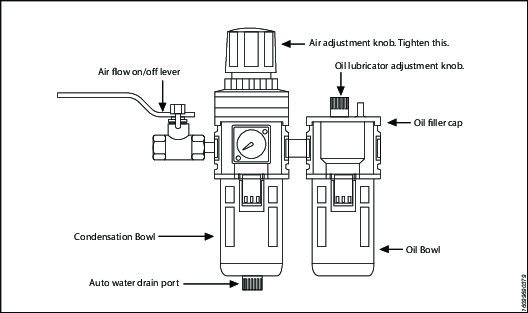RTX-04
Hydraulic Torque Wrench
产品信息
一般信息
安全警示语
危险、警告、小心和注意等安全警示语的意思如下:
危险 | 危险表示一种危险的情况,如果不能避免,将会导致死亡或严重伤害。 |
警告 | 警告表示一种危险的情况,如果不能避免,可能导致死亡或严重伤害。 |
小心 | 小心与安全警告标志一起使用,表示一种危险的情况,如果不能避免,可能会导致轻微或中等程度的伤害。 |
注意 | 注意用于指示与个人伤害无关的操作。 |
质保
产品保修在首次启用产品后 12 个月内有效,但无论如何,最迟应在交付产品后 13 个月内过期。
保修不包括部件正常的磨损和断裂。
“正常磨损和断裂部件”是指在工具常规维护期内,需要更换、进行其他调整/大修的部件(以时间、运行时数或其他形式表示)。
产品保修以工具及组件的正常使用、维护和修理为前提。
本保修不适用于在保修有效期内因维护保养不当或由 Atlas Copco及其授权维修服务合作伙伴之外的他方进行维修保养而造成的损坏部件。
要避免工具零配件损坏或断裂,请按建议的维护周期保养工具并严格遵守说明操作。
保修类修理仅在 Atlas Copco维修间或由获得授权的维修服务合作伙伴处理。
Atlas Copco通过ToolCover 合约提供延保及最佳的预防维护服务。有关详情,请联系您当地的服务代表。有关详情,请联系您当地的服务代表。
电动马达:
保修仅适用于未打开过的电动马达。
网站
有关我们的产品、配件、备件和已发布事项的信息,请访问 Atlas Copco 网站。
请访问:www.atlascopco.com.
ServAid
ServAid 是一个持续更新的门户网站,含有技术信息,例如:
法规和安全信息
技术数据
安装、操作和维修说明
备件列表
附件
尺寸图
请访问:https://servaid.atlascopco.com.
如需进一步的技术信息,请联系您当地的 Atlas Copco代表。
安全数据表 MSDS/SDS
安全数据表描述了 Atlas Copco销售的化学产品。
有关更多信息,请访问 Atlas Copco网站 www.atlascopco.com/sds。
原产地
对于原产地,请参见产品标签上的信息。
尺寸图
尺寸图可以在尺寸图存档或 ServAid 上找到。
请访问:http://webbox.atlascopco.com/webbox/dimdrw或 https://servaid.atlascopco.com。
概览
产品技术数据
产品技术数据可以在 ServAid 或 Atlas Copco网站上找到。
请访问:https://servaid.atlascopco.com或 www.atlascopco.com。
保养概述
维修建议
建议定期进行预防性维护。请参见预防性维护的详细信息。如果产品工作不正常,请勿运行并对其检查。
如果未包含预防性维护的详细信息,须遵守一般操作指南:
彻底清洗相应的零部件
更换任何故障或磨损零部件
操作
人体工学指导准则
通读此一般人体工学指导准则列表时考虑您的工作台,找出在姿势、组件放置或工作环境方面可以改进的地方。
请频繁地间歇并更换作业位置。
根据需求和工作任务调整工作台区域。
通过确定需要放置零件和工具的位置调整出方便的范围,避免静态运功。
使用工作台设备,例如适合工作任务的桌椅。
避免作业位置高于肩部水平线或在装配操作期间静态持握工具。
在肩部水平线以上位置作业时,通过减轻工具重量来减少静态的肩部肌肉负担,例如使用扭矩臂、软管卷盘或重量平衡器。您也可以通过在近身位置持握工具来减轻静态的肩部肌肉负担。
经常休息。
避免肩部或腕部使用极端姿势,尤其在需要使用一定力量的操作过程中。
调整出方便的视野,使眼睛和头部的运动最少。
处理工作任务时使用适当的照明。
处理工作任务时选择适当的工具。
在嘈杂的环境中,请使用护耳设备。
使用高质量插入式工具和消耗品以最大限度减少暴露于过度振动的情况。
操作说明
工作压力
The tool's maximum working pressure is 10,000 psi (700 bar). Make sure that all hydraulic equipment (pumps, hoses, couplers) used with this tool are rated for 10,000 psi (700 bar) working pressure. Review the documentation for the hydraulic pump in use to ensure pressure does not exceed 10,000 psi.
Electric Connections
Ensure proper power availability to prevent motor failure or dangerous electrical overloading. Use the recommended amperage listed on the motor nameplate. Do not use electric pump if ground is not connected on plug.
尽量缩短延长线的长度,确保电线具有适当的线径并接地。
Extension cord should be #10 AWG gauge.
空气连接
Ensure that you have sufficient air flow (58 up to 100 PSI / 4 up to 7 bar) to operate you pneumatic pump. If in doubt, compare the pump manufacturer's recommended air flow rating prior to pressurizing pump. Improper air flow may damage the pump motor.

For best results use air hoses equal or larger than 3/4” internal diameter.
Use of a F.R.L. (Filter Regulator Lubricator) is highly recommended. Fill with oil and adjust the air admission with the adjustment knob.
液压连接
Our hydraulic pumps are equipped with a zero-pressure relief valve. However, it could be possible that the retract side remain pressurized after the pump has been switched “off”. This trapped pressure prevents the user from loosening the retract-side fittings by hand. To release the pressure, simply push the black button on top of the solenoid. All fittings are free to be manually tightened.
Never disconnect or connect any hydraulic hoses or fittings without first unloading the wrench and the pump. If the system includes a gauge, double check the gauge to assure pressure has been released. When making connections with quick disconnect couplings, make sure the couplings are fully engaged. 如配件、仪表等螺纹连接处必须保持清洁、牢固拧紧且无泄漏。
General Setup
All our hydraulic torque wrenches are supplied completely assembled, ready for use. An Atlas Copco hydraulic power pack, for use with your Atlas Copco hydraulic torque wrench, is recommended to provide the speed, pressure and portability that make your Atlas Copco System efficient and accurate.
The accuracy of your Atlas Copco hydraulic torque wrench is +/-3% based upon our manufacturer's specifications. This accuracy is certified through calibration tests conducted by Atlas Copco or any other qualified calibration facility whose program is traceable to the National Institute of Standards and Technology (N.I.S.T). We strongly suggest using Atlas Copco certified gauges (with a class 1 accuracy) to enhance the accuracy your torquing system.
维修
维护说明
保养和维护建议
进行工具的操作、修理或维护工作或者更换工具附件或靠近操作现场时,要戴上耐冲击的眼部和面部护具。
仅在整个系统处于零压力时才能进行所有检查、维护或修理工作。
为了获得最佳性能,要经常检查工具、动力装置、软管、连接器、电线及附件是否存在可见损坏。务必遵循工具和泵的维护说明。
保养间隔指南
接受过正规培训的人员按照正确的维护计划使用液压扳手,方可确保长期无故障地使用。但所有工具在长期使用后都会磨损。影响工具寿命的因素:
高循环率
高负载使用
冲击
在脏污、高温或潮湿的环境中操作
不同的反作用力方法
维护不当
建议定期润滑和检修,以确保扳手保持良好的工作状态。如果在高扭矩、高周期率或长拧紧时间条件下使用,则保养间隔应更频繁。如果扳手不能正常工作,应立即将其取下检查。
以下保养间隔仅供参考。每个用例和应用都不一样,因此最终用户有责任针对工作环境和使用实施适当的有计划维护。记录工具操作情况。此记录有助于规划工具或部件的维修、校准和更换。
轻型
例如:很少在低压下使用,容量 <40%。
润滑:每 6 个月
检修:每 12 个月
正常负载
例如:常规使用,容量 <80%。
润滑:每 3 个月
检修:每 12 个月一次,包括更换驱动销。请参阅润滑部分。
重负载
例如:在任何压力下持续使用;使用 >80% 容量;定期使用以松开腐蚀的螺栓。
润滑:每个月
检修:每 6 个月一次,包括更换驱动销和驱动棘爪。请参阅润滑部分。
工具更换
产品所有者必须实施符合工具更换政策的维修计划。该政策确保在工具失效之前进行更换。由于操作环境和工具维护的潜在差异,很难定义工具的使用寿命。
若存在明显的磨损痕迹(如划痕、凹痕或材料缺失),表明工具已失效。对出现磨损迹象的工具进行维修。为使工具保持良好状态,应更换损坏的部件。若工具的压力承载部件或反作用力臂出现严重损坏,则出于安全原因,应移除该工具。
更多信息,请参阅维修间隔指南。
预防性维护
为了保持液压扭矩扳手系统处于良好的工作状态,请在每次使用后执行以下维护步骤。
擦拭干净所有外表面,目检工具是否有损坏迹象。必要时进行调查。
检查所有液压接头和连接是否有液压泄漏迹象。必要时进行调查。
确保所有液压联轴器清洁且无碎屑。
检查整条软管;查看是否有切口或擦伤。密切注意锻造的端部,查看是否有任何泄漏迹象。
如果设备处于良好的工作状态,可喷上合适的防锈油,如 Shell Ensis 或 Castrol Rustillo,并储存好以备下次使用。
检修说明书
将扳手连接到泵上。
执行压力测试,以确保所有机构均按预期运行。
调查任何故障或液压泄漏。
给系统减压并断开所有联轴器。
拆卸扳手。
更换所有密封件和弹簧。
更换驱动销。
更换有损坏或磨损迹象的任何其他部件。
重新润滑并重新装配扳手。
执行压力测试,以确保所有机构均按预期运行。
校准扳手以确保扭矩输出符合预期。
润滑说明
润滑剂指南
驱动组件 | Molykote 1000 |
密封件 | Rocol Sapphire Aqua-Sil |
紧固件 | Loctite 243 |
锥形液压螺纹 | Loctite 577 |
润滑
为使扳手保持良好的工作状态,在保养间隔期内定期对驱动部件进行润滑。
润滑前拆卸:
卸下侧板螺钉和侧板 [1]。
拆下驱动组件 [2]。

在润滑维护期间执行以下操作:
检查驱动销和弹簧有无磨损或损坏迹象。如有必要,更换驱动销和弹簧。
检查棘轮齿边缘是否有损坏迹象。如有必要,更换棘轮。
检查驱动棘爪齿是否有损坏迹象。如有必要,更换驱动棘爪。
检查驱动棘爪弹簧是否有损坏迹象。如有必要,更换弹簧。
用 Molykote 1000 润滑阴影区域。
组装程序与拆卸程序相同,但相反。
疑难解答
Troubleshooting Powerpacks
Atlas Copco Hydraulic Power Packs are precision-built units and, as such, do require a certain amount of care and maintenance
Hydraulic Oil should be completely changed after every 300 hours of operation, or at least twice a year. Always make sure the reservoir is filled with fluid. Always use Atlas Copco Maximizer range of oils for best performance.
Couplers and fittings should be checked periodically for leaks. Dirt or foreign materials should be kept away from fittings. Clean before use.
Hydraulic Gauge: TITAN 压力表内注入了液体。如果此液位下降,表示有外部泄漏,需要更换。如果压力表内出现液压油,表示有内部损坏,不应继续使用。
Filter on Pump: The filter should be replaced twice a year in normal use and more often if the pump is used daily or in a dirty, harsh environment.
遥控器 (Air Unit) The airline to the remote control unit should be checked for obstructions or kinks in the line periodically. If there is a bend or break in the line, it must be replaced. The spring- loaded buttons on the remote handle should be checked in the event of operating difficulties. (Electric Unit) The switch buttons should be checked periodically if any indications of problems exist.
Air Valve: This valve should be checked twice a year.
Armature: (Electric Unit) Check yearly.
Pumping unit: 每 2 年应对泵进行一次彻底检查。可以由 TITAN 或合格的液压维护中心进行检查。
Troubleshooting Routines
测试 1
Attach hoses to pump and tool in the normal manner.
Press the advance button and hold it down.

If the pump pressure builds and the hoses "flex" but the tool still refuses to cycle, the problem is most likely a loose or defective coupling connection. To find out where the bad coupling is, remove the tool from the hoses and marry the loose ends together and cycle the pump. If the gauge pressure reads no more than 500 PSI, then the bad fitting is on the tool. A significantly greater pressure indicates that the problem is in either the pump or a hose fitting.
测试 2
Remove screws from pump motor to reservoir, slide pump motor to the back while keeping pistons into oil.
Turn pump on. If you have no oil coming out from the solenoid tube, change the solenoid.
Tight the regulating valve to maximum, Push on the advance button and while holding down, look if any oil is coming out from the regulating tube. If oil is coming out, change the regulating valve.
测试 3
Remove tool from hoses.
Cycle pump.

If pump fails to build pressure, the problem is with the pump. If it does build pressure, the problem is with hydraulic blow-by in the tool.
测试 4
This test should be run prior to every use of an Atlas Copco Tool
Connect the tool, pump and hoses together as normal.
Cycle the pump several times.
Cycle the system once more and observe the sequence of operation.
As you depress the advance button, the tool drive shroud turn about 24 degrees and you should hear an audible "click". You will also notice that the disengagement levers will move to the rear of the tool and spring forward.
At this point, release the advance button. You should see no further movement and after a moment you will hear another audible "click". This is how the tools are designed to operate.
If you observe any other sequence of operation, the system is out of order and cannot deliver more than 10% of its designed capacity.
Take immediate corrective action. For reference, tools and pumps are designed from the factory plumbed as follows. This ensures that the tool, pump and ONE hose cannot possible be connected up incorrectly.
测试 5
工具 | 软管 | 泵 |
|---|---|---|
Advanced Side-Male | Advance side- Female to Female | Advance side-Male |
Retract side-Female | Retract Side-Male to Male | Retract Side-Female |
Note that connecting two (or any even numbers) of hoses together creates "one" hose which is plumbed backwards! Male to Female and Female to Male. This will cause the system to operate backwards per Test #5 above. If you hose isn’t long enough, connect 3 hoses together, move your pump or call Atlas Copco for a longer hose assembly.